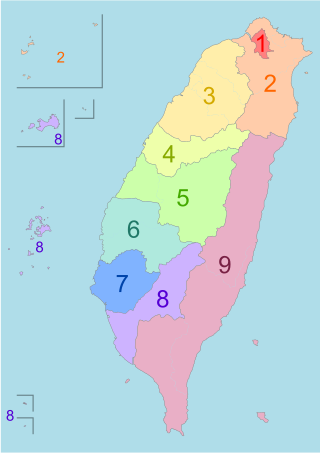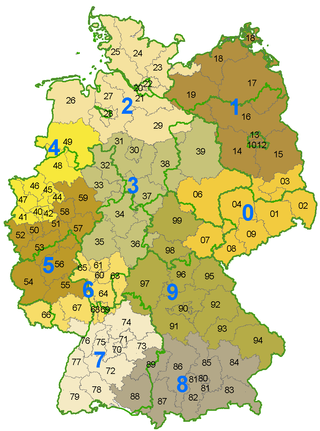
A postal code is a series of letters or digits or both, sometimes including spaces or punctuation, included in a postal address for the purpose of sorting mail.

A ZIP Code is a system of postal codes used by the United States Postal Service (USPS). The term ZIP was chosen to suggest that the mail travels more efficiently and quickly when senders use the code in the postal address.

Postal codes used in the United Kingdom, British Overseas Territories and Crown dependencies are known as postcodes. They are alphanumeric and were adopted nationally between 11 October 1959 and 1974, having been devised by the General Post Office. A full postcode is known as a "postcode unit" and designates an area with several addresses or a single major delivery point.

A Canadian postal code is a six-character string that forms part of a postal address in Canada. Like British, Irish and Dutch postcodes, Canada's postal codes are alphanumeric. They are in the format A1A 1A1, where A is a letter and 1 is a digit, with a space separating the third and fourth characters. As of October 2019, there were 876,445 postal codes using Forward Sortation Areas from A0A in Newfoundland to Y1A in Yukon.
A Postal Index Number refers to a six-digit code in the Indian postal code system used by India Post. On 15 August 2022, the PIN system celebrated its 50th anniversary.
Postal codes were introduced in France in 1964, when La Poste introduced automated sorting. They were updated to use the current 5 digit system in 1972.
Spanish postal codes were introduced on 1 July 1984, when the Sociedad Estatal de Correos y Telégrafos introduced automated mail sorting. They consist of five numerical digits, where the first two digits, ranging 01 to 52, correspond either to one of the 50 provinces of Spain or to one of the two autonomous cities on the African coast.

An address is a collection of information, presented in a mostly fixed format, used to give the location of a building, apartment, or other structure or a plot of land, generally using political boundaries and street names as references, along with other identifiers such as house or apartment numbers and organization name. Some addresses also contain special codes, such as a postal code, to make identification easier and aid in the routing of mail.

Postal codes in the People's Republic of China are postal codes used by China Post for the delivery of letters and goods within mainland China.
Postal codes in Argentina are called códigos postales. Argentina first implemented a four-digit postal code system in 1958, aiming to improve mail distribution efficiency. However, it wasn't until 1998 that the more detailed and comprehensive Código Postal Argentino (CPA) system was launched, significantly enhancing both accuracy and efficiency in mail delivery. Until 1998 Argentina employed a four-digit postal code for each municipality, with the first digit representing a region in the country, except in the case of the city of Buenos Aires. The unique codes became the base for the newer system, officially called CPA.
A Peruvian postal code is a five-digit string that comprises part of a postal address in Peru. Prior to 2011, only the major cities of Lima and Callao used postal codes. However, in February 2011 a nationwide system was implemented which employs a five-digit numeric format. Similar to the postal codes of Mexico, Brazil, Australia, the United States, and elsewhere, postal codes in Peru are strictly numerical, using only numbers.

According to the Political Constitution of Costa Rica of 1949, in article 168, the territorial division of Costa Rica is organized by law into three types of subnational entity:

Postal codes in Taiwan is a system of three + three digits used by Chunghwa Post. There are 368 sets of three-digit codes for townships, county-administered cities, and districts in Taiwan.

Postal codes in Thailand are five digit numbers. The first two digits of the postal code denote the province or special administrative area, while the last 3 digits represent the post office within the province. There are exceptions, for example, Bangkok and Samut Prakan province shared the first two digits 10xxx. It's typical to use postal code ended with zero 0 because they are assigned to post office that are responsible for delivering mail to the district. For example, mails to Dusit district destinations uses postal code 10300 except within Chitralada Palace where postal code 10303 is used. 10300 is postal code of Dusit Post Office which handles the delivery throughout Dusit district while 10303 is postal code of Chitralada Palace Post Office which does not deliver mails outside the palace. Other post offices in Dusit district exist, such as Bang Krabu Post Office with postal code 10301, the code used for mails to be delivered to P.O. Box in the post office.

Germany introduced postal codes on 25 July 1941, in the form of a two-digit system that was applied initially for the parcel service and later for all mail deliveries. This system was replaced in 1962 in West Germany by a four-digit system; three years later East Germany followed with its own four-digit system. Whereas the Federal Republic introduced a system with space left for the East German postal system after a possible reunification, such as by omitting all codes starting with '1' and '9', the German Democratic Republic had a system that used all codes starting from '1' to '9' just for East Germany.
Postal codes in South Korea are composed of five digits. A new system of post codes was introduced on August 1, 2015. The first postal code in South Korea was established on July 1, 1970, and has been revised three times: in 1988, 2000, and 2015.

Postal codes in Indonesia, known in Indonesian as kode pos consist of 5 digits.

The Thai addressing system is used to identify a specific location in Thailand. It generally corresponds closely with the administrative divisions of Thailand.
Yugoslavian postal codes were introduced on January 1, 1971 and consisted of five digits. The first two digits roughly corresponded to the routing zones, mostly matching each of the Yugoslav republics: 1, 2 and 3 for Serbia, 4 and 5 for Croatia, 6 for Slovenia, 7 for Bosnia and Herzegovina, 8 for Montenegro and 9 for Macedonia. District seat cities usually had 000 as the last three digits, while smaller towns and villages had non-round last three digits.
Postal codes used in Saudi Arabia are colloquially known as postcodes.











